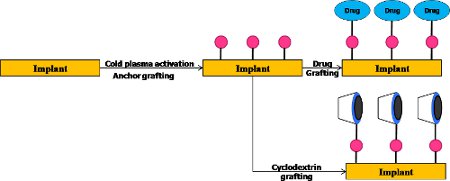Polymer systems engineering
- Home
- Team directory
- Publications
- Communications
- PhD thesis
- Collaboration network
- Former group members
Equipements
- General database
- Electron Microscopy Platform
- X-ray diffraction and diffusion
- Mechanical tests
- Thermal analysis
- Mise en oeuvre de polymères
- Fire tests
- Surface treatment
- Analytical and Technical Instruments
- Equipment for textiles
- Polymer Practical Courses
Ongoing projects
Topics
- Novel concept of antimicrobial packaging polymers
- Controlled Radical polymerizations
- Supramolecular Chimistry
- Functional polymeric systems
- Micro and nanoparticular systems for the sustained delivery of active molecules
- Cold plasma functionalization of biomaterials
- Elaboration of biomaterials for therapeutic applications

Polymer systems engineering
Cold plasma functionalization of biomaterials
The goal of our team “Systèmes polymers fonctionnels” is to functionalize surfaces of polymeric biomaterials, in order to improve their biocompatibility and bring new therapeutic activities. This functionalization is obtained via cold plasma treatment.
Two pathways are developed after the cold plasma treatment:
-
the enhancement of biocompatibility is obtained by grafting functional polymers onto the surface. Functionalities are chosen depending on the expected effect against cell vitality, adhesion or platelet adhesion, hemocompatibility...
Two methods are investigated: the grafting of functional polymer onto the activated surface (“grafting onto”) or the grafting polymerization of the polymer surface with functional monomers (“grafting from”).
the introduction of new therapeutic properties is carried out by incorporating drugs with an in situ therapeutic effect (Scheme).
For a long term effect, the suggested pathway consists in grafting onto the surface functional polymers bearing the drug or grafting a functional polymer which will play the role of an anchor for drug immobilization.
For a limited in time effect, the ability of cyclodextrins to form complexes with bioactive molecules is used. After cyclodextrin grafting, the drug is adsorbed onto the surface and its release happens for an extended time in the biological environment. These systems are called Drug Delivery Systems.
The choice of bioactive molecules/functions is determined depending on the expected therapeutic effect (antibiotic, anti-inflammatory drug...).
The effectiveness of this activity and its evolution with time are studied by means of biologic tests, carried out in collaboration with Groupe de Recherche sur les Biomatériaux from Université de Lille 2 (U1008).


